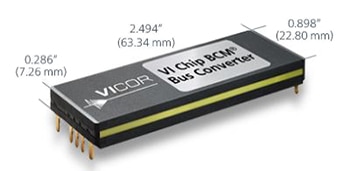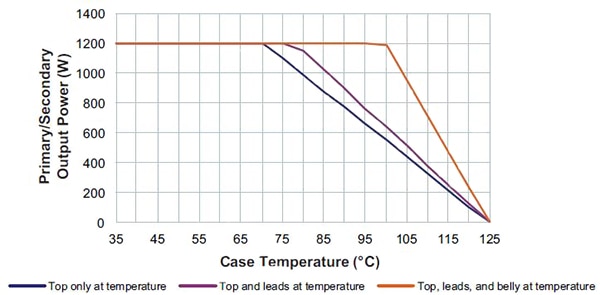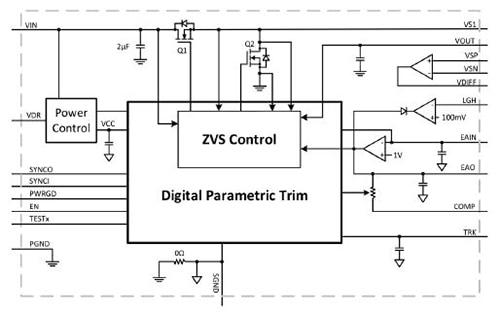Techniques to Improve System Power Density
投稿人:电子产品
2016-01-14
With shrinking product dimensions, there is continuous pressure on power supply designers to reduce the size of power converters, such as DC/DC and AC/DC converters, while maintaining performance. Simply getting the power to the load, however, is only one piece of the story: efficiency must be optimized and EMI reduced in addition to ensuring that the system is rugged enough to fulfill anticipated applications. Still, developing a power chain that takes less space will allow for more room for other parts of the system and, fortunately, designers can now utilize a number of ways to improve power density and trim the size of these power converters. In its PowerBlog, Vicor recently addressed this issue directly1, coming up with seven different techniques to shrink the size of power supplies. These include using smaller components, eliminating heatsinks, utilizing unwanted space in products, avoiding the use of bulk capacitance, minimizing filters, changing bus voltages, and cutting conversion stages in power distribution systems.
One way to use smaller components is to use higher-switching frequencies. However, higher-switching frequency can result in higher-switching losses and, in turn, lower conversion efficiency. However, by selecting the right topology for the frequency, switching losses can be minimized to achieve high efficiency. Let’s look at one example, Vicor’s ChiP bus-converter modules (BCM). By combining resonant topology with advanced packaging such as Vicor’s Converter housed in Package (ChiP), BCM modules can deliver over 1 kW of power from a miniature package with 5 times improvement in power density as compared to similar solutions in the market. In addition, these modules are designed to realize over 98 percent efficiency with power density as high as 2750 W/in3 (167 W/cm3).
Smaller passives
To use smaller passive components, the BCM employs resonant topology, such as Vicor’s zero-current switching/zero-voltage switching (ZCS/ZVS) Sine Amplitude Converter (SAC) architecture to switch at frequencies as high as 1.25 MHz. By keeping the switching and conduction losses low, and passive components smaller, the BCM DC/DC converter can integrate controller, power switches, and support components in a single high-density system-in-package (SiP) measuring only 63.34 x 22.80 x 7.26 mm (Figure 1). The high efficiency of the design, in combination with advanced packaging, simplifies thermal management of ZCS/ZVS sine amplitude converters like the BCM380P475T1K2A30.

Figure 1: Combining high frequency with advanced packaging, Vicor’s high-voltage VI ChiP BCM converter delivers unprecedented power density while realizing efficiency of up to 98 percent.
From this compact package, the BCM converter can deliver up to 1200 W continuous output power from an input-voltage range of 260 V to 410 V. The isolated output-voltage range for this fixed-ratio DC/DC converter is 32.5 V to 51.3 V with 48 VDC as the nominal output voltage. According to the supplier, the advanced ChiP packaging technology enables the BCM module to remove heat from the top surface, the bottom surface, and the leads. As a result, the module can offer maximum output power over a wide case temperature of the package without using any external heatsink (Figure 2).

Figure 2: The advanced ChiP-packaging technology enables the BCM converter to remove heat from three surfaces and, thereby, offer a wide thermal operating area from a high-density package.
Besides using smaller passives and novel thermal-design, the ChiP packaging also allows for placing components on both sides of the substrate to boost power density. What is more, to further improve power density it utilizes an integrated magnetic structure embedded in the highly dense substrate. The result is unparalleled power densities. In fact, implementing these advances, Vicor has achieved a new high in density. Supplying up to 1.75 kW with 98 percent peak efficiency, Vicor’s BCM400P500T1K8A30 has demonstrated 2735 W/in3 power density.
Eliminating filters
Normally, to ensure that the power supply can respond quickly to load transients, large-output capacitors are used, which increases the size of the power solution and in turn reduces density. Vicor’s factorized power architecture (FPA) addresses this problem. FPA is a proprietary alternative solution to the industry’s distributed power architecture (DPA). Again per the Vicor Powerblog article1, it allows the capacitance to be moved to the input of the company’s voltage transformation module or VTM, a point-of-load (POL) solution. Because the input to VTM is several times the voltage at the output, the capacitance required at the input is much lower. Thus, by moving the capacitance, designers can replace the large bulk capacitance with a small ceramic capacitor, according to Vicor.
Unlike hard-switched PWM converters that generate significant amount of electromagnetic interference (EMI), soft-switched resonant converters eliminate EMI. In addition, by operating at higher switching frequencies, resonant converters reduce the size of the filters. For instance, take a look at the data sheet for the BCM module BCM380P475T1K2A30 mentioned earlier. The input- and output-filter design section indicates that PWM converters based on ZVS/ZCS SAC do not need external filtering to function properly. A small amount of capacitance is embedded in the primary and secondary stages of the module, which is sufficient for full functionality and is key to achieving high-power density, Vicor reports.
Traditionally, distributed power systems use intermediate bus architecture (IBA) to step-down high-voltage bus to 12 VDC or lower bus voltage, which is further lowered by another converter to power the load. This two-stage power conversion to drive the IC load reduces the overall efficiency while adding to the cost and size of the solution. By using a high-step ratio converter like the Vicor ZVS Cool-Power PI3542-00-LGIZ, a single stage can convert 48 VDC down to 2.5 VDC at 10 A with peak efficiency of 90 percent. The input voltage range is 36 V to 60 V. Like the BCM modules, the Cool-Power buck converters also utilize resonant ZVS topology to switch at high frequency of 400 kHz to utilize smaller passive components. Consequently, it can also pack controller, power switches, and support components in a single LGA SiP measuring just 10.0 x 10.0 x 2.6 mm (Figure 3). However, unlike high-voltage and high-power BCM modules, the ZVS-based Cool-Power buck regulators are designed for much lower power and POL application.

Figure 3: ZVS buck converter PI3542-00-LGIZ is a high step-down DC/DC converter capable of converting 48 VDC input to 2.5 VDC output at 10 A.
Designers should note that Vicor is not the only power supply maker to exploit these techniques to boost the power density of its converters while offering higher efficiency and faster transient response with minimum filtering and EMI interference. Others like Intersil, Linear Technology, and Texas Instruments are also in the race to deliver high-power-density solutions without compromising performance.
For more information on the products discussed in this article, use the links provided to access product pages on the Digi-Key website.
References
- PowerBlog, “7 Ways to Shrink Your Power System,” Vicor Corp., Andover, Mass.
免责声明:各个作者和/或论坛参与者在本网站发表的观点、看法和意见不代表 DigiKey 的观点、看法和意见,也不代表 DigiKey 官方政策。








